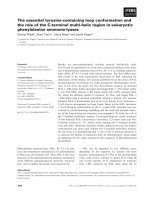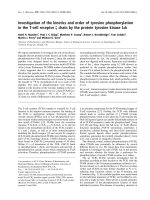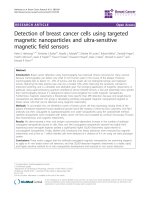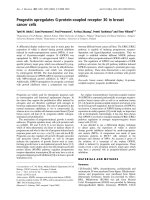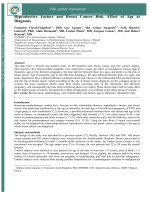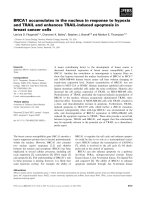Heregulin enhanced tyrosine phosphorylation in breast cancer cells role of PP2A in HER 2 eu oncogenic signalling
Bạn đang xem bản rút gọn của tài liệu. Xem và tải ngay bản đầy đủ của tài liệu tại đây (21.23 MB, 214 trang )
HEREGULIN-ENHANCED TYROSINE PHOSPHORYLATION
IN BREAST CANCER CELLS:
ROLE OF PP2A IN HER-2/NEU ONCOGENIC SIGNALLING
WONG LEE LEE
(B.Sc., NUS)
A THESIS SUBMITTED
FOR THE DEGREE OF DOCTOR OF PHILOSOPHY
DEPARTMENT OF PATHOLOGY
YONG LOO LIN SCHOOL OF MEDICINE
NATIONAL UNIVERSITY OF SINGAPORE
2010
Acknowledgements
I
ACKNOWLEDGEMENTS
It would not have been possible to complete my journey in this doctoral thesis without
the help and support from many kind people around me.
I am heartily thankful to my supervisor, Associate Professor Evelyn Koay, for her
constant encouragement, guidance and support from the preliminary to the concluding
level of my graduate study. Despite her hectic schedule, she always makes time for her
students. I have benefited from her wisdom and her sharing of life experience in Science.
I am grateful to my co-supervisors, Associate Professor Chang Chan Fong and Dr Zhang
Daohai for their valuable discussion and technical advices as well as sharing their
expertise in scientific knowledge.
I would like to show my gratitude to my Ph.D. Thesis Advisory Committee members,
Professor Bay Boon Huat and Associate Professor Yip Wai Cheong, George as well as
the thesis examiners for their time and effort to make this thesis possible.
I am indebted to my many present and former friends and colleagues at Special
Histopathology, Department of Pathology, NUS and Molecular Diagnosis Centre,
Department of Laboratory Medicine, NUH for their kind assistance and precious
friendship.
This thesis would not have been possible without the immense love and unequivocal
support from my family. To my loving husband Julian, thank you for being my strong
support and accompanying me through the joy and sorrow of this wonderful journey.
Last but not least, give thanks to our Lord for His abundant love and blessing to me!
Table of contents
II
TABLE OF CONTENTS
ACKNOWLEDGEMENTS I
TABLE OF CONTENTS II
SUMMARY VI
PUBLICATIONS VIII
LIST OF TABLES X
LIST OF FIGURES XI
LIST OF ABBREVIATIONS XV
CHAPTER 1 INTRODUCTION 1
1.1 Breast cancer 1
1.1.1 Incidence of breast cancer 1
1.1.2 Classification of breast cancer 3
1.1.3 Aetiology of breast cancer 6
1.2 HER-2/neu-positive breast cancer 8
1.2.1 Definition 8
1.2.2 Clinical significance of HER-2/neu as a prognostic indicator in breast cancer 11
1.2.3 Diagnosis of HER-2/neu-positive breast cancer 13
1.2.4 Signalling networks regulated by HER-2/neu 20
1.2.5 Therapeutic interventions in HER-2/neu-positive breast cancer patients 22
1.2.6 Current findings of HER-2/neu-linked studies 24
1.3 Protein post-translational modifications 29
1.3.1 Definition 29
1.3.2 Protein phosphorylation and the role of protein kinases 30
1.3.3 Protein phosphorylation and the role of phosphatases 31
1.4 Protein phosphatase type 2A (PP2A) 32
1.4.1 PP2A structure and function 32
1.4.2 PP2A and cancer 34
Table of contents
III
1.5 Gene silencing 36
1.5.1 Definition 36
1.5.2 Mechanisms of RNAi 38
1.5.3 RNAi as a tool of analysis 40
1.6 Rationale and objectives of this research project 41
CHAPTER 2 MATERIALS AND METHODS 44
2.1 Materials 44
2.1.1 Ligand and inhibitors 44
2.1.2 Antibodies 44
2.1.3 Cell-lines 45
2.1.4 Fresh frozen clinical specimens 45
2.2 Methods 46
2.2.1 Cell culture treatment 46
2.2.2 Protein extraction 47
2.2.3 Immunoblotting /Western blotting 49
2.2.4 Human phospho-receptor tyrosine kinase (Phospho-RTK) array analysis 49
2.2.5 Signal transduction antibody array analysis 50
2.2.6 Immunoprecipitation 51
2.2.7 Two-dimensional electrophoresis and immunoblotting 51
2.2.8 Immunohistochemistry and tissue microarray 52
2.2.9 RNA extraction 53
2.2.10 Reverse transcription polymerase chain reaction (RT-PCR) amplification 53
2.2.11 DNA agarose gel electrophoresis and DNA purification 54
2.2.12 DNA sequencing 54
2.2.13 Immunofluorescence and confocal microscopy 55
2.2.14 Biological assays 55
2.2.15 Statistical analysis 57
CHAPTER 3 HRG-ENHANCED HER-2/neu SIGNALLING 59
3.1 Overview 59
3.2 Results 61
3.2.1 HRG enhanced HER-2/neu phosphorylation in a dose- and time-dependent
manner 61
3.2.2 HRG is a specific activator of EGFR, HER-2 and HER-3 tyrosine
phosphoryation but not other receptor tyrosine kinases 63
Table of contents
IV
3.2.3 HRG stimulates phosphorylation of the HER-2 receptor/ErbB2 and its
downstream interacting signalling molecules 64
3.2.4 Differential tyrosine phosphorylation profiles between the HRG-treated and
DMSO-treated (control) BT474 cells, derived using signal transduction
antibody arrays 65
3.2.5 Validation of antibody array results 71
3.3 Discussion 73
CHAPTER 4 REGULATION OF PP2A BY HER-2/neu 77
4.1 Overview 77
4.2 Results 80
4.2.1 Inhibition of HER-2/neu signalling using AG825 80
4.2.2 HER2/neu signalling regulates tyrosine phosphorylation of PP2A 81
4.2.3 Inhibition of PI3K/AKT, MEK/ERK and p38 MAPK pathways 83
4.2.4 PI3K/AKT and MEK/ERK positively regulate, whereas p38 MAPK negatively
regulates tyrosine phosphorylation of PP2A 84
4.2.5 Stimulation of PP2A by HRG and the effects of inhibitors on tyrosine
phosphorylation of PP2A 87
4.3 Discussion 89
CHAPTER 5 CORRELATION OF PP2A AND BREAST CANCER 92
5.1 Overview 92
5.2 Results 94
5.2.1 pY307-PP2A was highly expressed in HER-2/neu-positive breast cancer cell
lines 94
5.2.2 pY307-PP2A was highly expressed in HER-2/neu-positive breast tumours 96
5.2.3 Expression levels of pY307-PP2A correlated with breast cancer progression 97
5.2.4 DNA sequencing of the PP2A catalytic subunit 100
5.3 Discussion 101
CHAPTER 6 FUNCTIONAL ROLE OF PP2A IN HER-2/neu BREAST CANCER
CELL LINES 105
6.1 Overview 105
Table of contents
V
6.2 Results 107
6.2.1 Silencing of PP2A/C using siRNA 107
6.2.2 Silencing of PP2A/C caused a decrease in pY307-PP2A expression and
attenuated tyrosine phosphatase activities 110
6.2.3 Silencing of PP2A/C led to a slight increase of the sub G1 phase in the cell
cycle 112
6.2.4 Silencing of PP2A/C facilitated cell apoptosis 113
6.2.5 Silencing of PP2A/C caused cell apoptosis via the p38 MAPK/Hsp27 signalling
pathway 117
6.3 Discussion 119
CHAPTER 7 GENERAL DISCUSSION AND CONCLUSION 124
7.1 The significance of deciphering the role of tyrosine phosphorylation in
HER-2/neu breast cancer cells 124
7.2 Antibody array-based technologies for cancer protein profiling and
functional proteomics analyses 126
7.3 PP2A as a tumour suppressor or proto-oncogene? 128
7.4 The role of PP2A in HER-2/neu-overexpressing breast cancer 131
7.5 Use of siRNA in cancer therapy 132
7.6 Conclusion 134
7.7 Future works 135
REFERENCES 137
APPENDICES 162
Summary
VI
SUMMARY
HER-2/neu is an established adverse prognostic factor of breast cancer. Patients with
tumours overexpressing HER-2/neu have significantly shortened overall survival.
Studying the mechanisms by which HER-2/neu overexpression translate into the more
aggressive biological phenotype would not only provide a better understanding of the
increased virulence of breast cancers overexpressing this oncogene but may also lead to
rational targeted therapeutic strategies to arrest cancer growth.
Activation of HER-2/neu leads to activation or suppression of multiple signalling
cascades and plays a vital role in cell survival and growth. A signal transduction antibody
array was used in this study to characterize the tyrosine phosphorylation profiles in
heregulin (HRG)-treated BT474 breast cancer cells.A group of 80 molecules in which
tyrosine phosphorylation was highly regulated by HRG-enhanced HER-2/neu signalling
was identified. These phosphoproteins included many known HER-2/neu-regulated
molecules (e.g., Shc, AKT, Syk and Stat1) and proteins that had not been previously
linked to HER-2/neu signalling, such as Fas-associated death domain protein (FADD),
apoptosis repressor with CARD domain (ARC), and protein phosphatase type 2A
(PP2A).
Pharmacological inhibition with the HER-2/neu inhibitor AG825, PI3K inhibitor
LY294002, MEK1/2 inhibitor PD98095, and p38 MAPK inhibitor SB203580, confirmed
that PP2A phosphorylation was modulated by the complicated, HER-2/neu-driven
downstream signalling network, with the PI3K and MEK1/2 positively, while the p38
MAPK negatively, regulating its tyrosine phosphorylation.
Summary
VII
In breast tumour specimens and cell lines, expression of tyrosine
307
-phosphorylated PP2A
(pY307-PP2A) was highly increased in the HER-2/neu-positive breast tumours and cell
lines, and significantly correlated to tumour progression, thus enhancing its potential
prognostic value. The data in this thesis provides meaningful information in the
elucidation of the HER-2/neu-driven tyrosine phosphorylation network, and in the
development of phosphopeptide-related targets as prognostication indicators.
PP2A, in its activated form as a phosphatase, is a tumour suppressor. However, when
PP2A is phosphorylated at the tyrosine residue (pY307), it loses its phosphatase activity
and becomes inactivated. A higher expression of pY307-PP2A in HER-2/neu- positive
breast tumour samples, which was significantly correlated to tumour progression was
reported here, and in this context, PP2A could function as a proto-oncogene.
The above and subsequent findings led us to postulate that the critical role of PP2A in
maintaining the balance between cell survival and cell death may be linked to its
phosphorylation status at its Y307 residue. Hence, further investigatation on the effects
of knocking down the PP2A catalytic subunit which contains the Y307 amino acid
residue in two HER-2/neu-positive breast cancer cell lines, BT474 and SKBR3 were
carried out. The results showed that this caused the silenced HER-2/neu breast cancer
cells to undergo apoptosis and furthermore, that such apoptosis was mediated by p38
MAPK-caspase 3/ PARP activation. Understanding the role of PP2A in HER-2/neu-
positive cells might thus provide insight into new targets for breast cancer therapy.
Publications
VIII
PUBLICATIONS
Publications related to this thesis:
1. Wong L.L., Zhang D., Chang C.F., Koay E.S. (2010) Silencing of the PP2A catalytic
subunit causes HER-2/neu positive breast cancer cells to undergo apoptosis.
Experimental Cell Research. In press (DOI number: 10.1016/j.yexcr.2010.06.007),
PMID: 20558158. Impact factor: 3.589
2. Wong L.L., Chang C.F., Koay E.S., Zhang D. (2009) Tyrosine phosphorylation of
PP2A is regulated by HER-2 signalling and correlates with breast cancer progression.
International Journal of Oncology. 34(5):1291-1301. Impact factor: 2.447
Other publications:
1. Zhang D., Wong L.L., Koay E.S. (2007) Phosphorylation of Ser78 of Hsp27
correlated with HER-2/neu status and lymph node positivity in breast cancer.
Molecular Cancer. 6:52. Impact factor: 4.160
2. Zhang D., Tai L.K., Wong L.L., Chiu L.L., Sethi S.K., Koay E.S. (2005) Proteomics
study reveals that proteins involved in metabolic and detoxification pathways are
highly expressed in HER-2/neu-positive breast cancer. Mol. Cell. Proteomics.
4(11):1686-96. Impact factor: 8.791
3. Zhang D.H., Tai L.K., Wong L.L., Sethi S.K., Koay E.S. (2005) Proteomics of breast
cancer: enhanced expression of cytokeratin19 in human epidermal growth factor
receptor type 2 positive breast tumours. Proteomics. (7):1797-805. Impact factor:
4.426
4. Zhang D.H.*, Wong L.L.*, Tai L.K., Koay E.S., Hewitt R.E. (2005) Overexpression
of CC3/TIP30 is associated with HER-2/neu status in breast cancer. J. Cancer Res.
Clin. Oncol. 131(9):603-8. Impact factor: 2.261
*Equal Contribution
Meeting Proceedings:
1. Wong L.L., Zhang D., Chang C.F., Koay E.S. Deciphering the PP2A-mediated
signalling modulation in breast cancer. Keystone Symposia Conference. 25-30 Jan
2009. Taos, New Mexico, USA
2. Wong L.L., Zhang D., Chang C.F., Koay E.S. Tyrosine-phosphorylated signal
modulators regulated by Heregulin-enhanced HER-2/neu signalling. HUPO 6th
Annual World Congress. 06-10 Oct 2007. Seoul, Korea.
Publications
IX
3. Wong L.L., Zhang D., Chang C.F., Koay E.S. Dissecting the heregulin-regulated
tyrosine phosphoproteome in breast cancer using antibody arrays. Joint Third
AOHUPO and Fourth Structural Biology and Functional Genomics Conference. 4-7
Dec 2006. Singapore.
4. Wong L.L., Boo X.L., Koay E.S., Zhang D. Hsp27 phosphorylation at residue Ser
78
was regulated by HER-2/neu-p38 MAPK pathway and strongly correlated with HER-
2/neu status and lymph node positivity in breast cancer. National Health Group Annual
Scientific Congress. 30 Sep-1 Oct 2006. Singapore
List of tables
X
LIST OF TABLES
Table 1-1 Breast cancer incidence and mortality worldwide
Table 1-2 Ten most frequent cancers affecting Singapore women, 2003-2007
Table 1-3 Risk factors for breast cancer
Table 1-4 HER-2/neu status and breast pathology
Table 1-5 Summary of HER-2/neu tests for breast cancer
Table 1-6 Comparison of IHC, FISH, CISH and SISH
Table 1-7 Mutations or abnormal expression of PP2A subunits found in human
cancers
Table 2-1 Amount of inhibitors used for different treatments
Table 2-2 PCR amplification steps
Table 3-1 Identified tyrosine-phosphorylated proteins from HRG-treated BT474
cells
List of figures
XI
LIST OF FIGURES
Figure 1-1 Number of cases with breast cancer and all cancer types in Singapore
females 1968-2002, by 5-year period
Figure 1-2 Gross anatomy of the human breast
Figure 1-3 Stages of breast tumour progression
Figure 1-4 Female breast cancer: age-specific incidence, 1998-2002
Figure 1-5 Structure of the c-erbB2 receptor, encoded by the HER-2/neu gene
Figure 1-6 IHC staining of HER-2/neu-encoded c-erbB2 receptors and the
scoring system
Figure 1-7 FISH staining of HER-2/neu gene copies
Figure 1-8 CISH staining of HER-2/neu gene copies
Figure 1-9 Schematic diagram of HER-2/neu signalling pathways that contribute
to tumorigenesis
Figure 1-10 Structure of PP2A
Figure 1-11 Summary of the multiple ways of intracellular PP2A regulation
Figure 1-12 Mechanism of RNAi
Figure 3-1 HRG stimulation of HER-2/neu activation
Figure 3-2 HRG is specific in its activation of EGFR, HER-2 and HER-3, as
shown by the Human Phospho-RTK array
Figure 3-3 HRG stimulated phosphorylation of HER-2 and its downstream
interacting signalling molecules
Figure 3-4 Differential tyrosine phosphorylation profiles between the HRG-
treated and DMSO-treated (control) BT474 cells, detected on signal
List of figures
XII
transduction antibody arrays
Figure 3-5 Validation of differential tyrosine phosphorylation of identified
proteins by Western blotting
Figure 4-1 Inhibition of HER-2/neu activation by AG825
Figure 4-2 Regulation of tyrosine phosphorylation (pY307) of PP2A by
HER2/neu signalling
Figure 4-3 Inhibition of PI3K/AKT, MEK/ERK, and p38 MAPK pathway
activation using their respective inhibitors
Figure 4-4 Effects of different inhibitors on tyrosine phosphorylation of PP2A
Figure 4-5 Stimulation of HRG and the effects of different inhibitors on tyrosine
phosphorylation of PP2A
Figure 5-1 Expression of PP2A and tyrosine-phosphorylated PP2A (pY307-
PP2A) in breast non-tumorigenic and cancer cell lines
Figure 5-2 Expression of PP2A and tyrosine-phosphorylated PP2A (pY307-
PP2A) in clinical breast non-tumour and tumour specimens
Figure 5-3 Representative immunohistochemical staining of pY307-PP2A on
tissue cores in a breast tissue microarray
Figure 5-4 DNA sequencing of the PP2A catalytic subunit (PP2A/C)
Figure 6-1 Silencing of PP2A/C using siRNA from siGENOME SMARTpool
®
PP2A
Figure 6-2 Silencing of PP2A/C reduced pY307-PP2A expression and its tyrosine
phosphatase activity
Figure 6-3 Silencing of PP2A/C caused a slight increase of the sub G1 phase in
the cell cycle
Figure 6-4 Silencing of PP2A/C caused caspase 3-dependent apoptosis
List of figures
XIII
Figure 6-5 Silencing of PP2A/C reduced phospho-ERK 1/2 expression and
enhanced phospho-AKT, phospho-p38 MAPK and phospho-Hsp27
Ser 78 expression
Figure 6-6 Proposed role of PP2A in HER-2/neu signalling pathway
List of abbreviations
XIV
LIST OF ABBREVIATIONS
2-DE 2-dimensional electrophoresis
5-HT 5-hydroxytryptamine
ADH Atypical ductal hyperplasia
Ago Argonaute
AKT Protein kinase B
Alg-2 Alpha-1, 3-mannosyltransferase
ALH Atypical lobular hyperplasia
APC Adenomatosis polyposis coli
ARC Apoptosis repressor with CARD domain protein
ATCC American Type Culture Collection
ATP Adenosine triphosphate
BAD BCL-2 associated death promoter
BCL-2 B-cell lymphoma 2
BPE Bovine pituitary extract
BRCA Breast cancer susceptibility protein
BSA Bovine serum albumin
CDC25A Cell division cycle 25 homolog A
Cdk Cyclin-dependent kinase
cDNA Complementary DNA
CEP17 Chromosome 17 centromere
CHAPS 3-[(3-Cholamidopropyl) dimethylammonio]-1-propanesulfonate
CISH Chromogenic in situ hybridization
CLA Conjugated linoleic acid
COX-2 Cyclooxygenase-2
CXCR4 Chemokine receptor
DAB 3, 3’ Diaminobenzidine
DCIS Ductal carcinoma in situ
Dicer dsRNA-specific RNAse III family ribonuclease
DMEM Dulbecco’s modified Eagle medium
DMSO Dimethyl sulfoxide
DNA Deoxyribonucleic acid
DTT Dithiothreitol
dUTP 2´-Deoxyuridine, 5´-Triphosphate
dsRNA Double stranded RNA
EDTA Ethylenediaminetetraacetic acid
EGFR Epidermal growth factor receptor
ELISA Enzyme-linked immunosorbent assay
ER Estrogen receptor
ETS E26 transformation specific
FADD FAS-associated death domain protein
FAK Focal adhesion kinase-1
FBS Fetal bovine serum
List of abbreviations
XV
FDA Food and Drug Administration (USA)
FISH Fluorescence in situ hybridization
GTPase Guanosine triphosphate hydrolase enzyme
HUT Hyperplasia of usual type
H&E Hematoxylin and eosin
HER-2/neu Human epidermal growth factor receptor type 2
hpRNAs Hairpin RNAs
HRG Heregulin
HRP Horseradish peroxidase
Hsp Heat shock protein
hTERT Telomerase reverse transcriptase
IDC Invasive ductal carcinoma
IHC Immunohistochemistry
IgG Immunoglobulin G
ILC Invasive lobular carcinoma
IMAC Immobilized metal ion/metal chelate affinity chromatography
IPG Immobilized pH gradient
LCIS Lobular carcinoma in situ
LCMS Liquid chromatography mass spectrometry
MAPK Mitogen-activated protein kinase
MEGM Mammary epithelial cell complete medium
miRNA MicroRNA
mRNA messenger ribonucleic acid
MUC4 Mucin-4
Myc Myelocytomatosis viral oncogene homolog (avian)
OA Okadaic acid
PAR Partition protein 6
PARP Poly (ADP-ribose) polymerase
PDCD-6 Programmed cell death protein 6
PDGFR Platelet-derived growth factor receptor
PBS Phosphate-buffered saline
PCR Polymerase chain reaction
PI3K Phosphatidylinositol 3-kinase
PKC Protein kinase C
PLC Phospholipase C
PPP Phosphoprotein phosphatases
PP1 Protein phosphatase 1
PP2A Protein phosphatase type 2A
PTP1B Protein tyrosine phosphatase 1B
PTEN Phosphatase and tensin homolog
PTM Protein post-translational modifications
PVDF Hybond-P polyvinylidene fluoride
pYMT Polyoma middle T
RISC RNA-induced silencing complex
RNAi RNA interference
RTK Receptor tyrosine kinase
List of abbreviations
XVI
rTDT Terminal deoxynucleotidyl transferase
RT-PCR Reverse transcription-polymerase chain reaction
SD Standard deviation
SDS-PAGE Sodium dodecyl sulfate polyacrylamide gel electrophoresis
Shc Src homology 2 domain-containing transforming protein
SILAC Stable isotope labeling with amino acids in cell culture
SISH Silver in situ hybridization
siRNA Small RNA
Src Sarcoma
ST Small tumour antigen
SV40 Simian virus 40
Syk Src-related protein tyrosine kinases
TBE Tris/Borate/EDTA
TBS-T Tris-buffered saline containing 0.1% Tween-20
TMA Tissue microarray
TNF Tumour necrosis factor
TUNEL Terminal deoxynucleotidyl transferase biotin-dUTP nick end labeling
TP53 Gene coding for p53
VEGF Vascular endothelial growth factor
Chapter 1 Introduction
1
CHAPTER 1
INTRODUCTION
1.1 Breast cancer
1.1.1 Incidence of breast cancer
Breast cancer is the second leading cause of cancer deaths in women today after lung
cancer and is the most common cancer among women globally (American Cancer
Society. Cancer Facts & Figures 2009. Atlanta: American Cancer Society; 2009).
According to the American Cancer Society, about 1.3 million women will be diagnosed
with breast cancer annually and about 465,000 women will die from this disease. In
general, the incidence of breast cancer has risen about 30% in the past 25 years in
western countries. Due to the increased early detection screening, the breast cancer rates
are reported to be on a rising trend in many countries, on the contrary, the deaths caused
by breast cancer is on a decreasing trajectory, presumably as a result of improved
screening and treatment. Based on the GLOBOCAN 2002 worldwide statistics on breast
cancer incidence, mortality and prevalence, Singapore ranked as having the highest breast
cancer incidence and mortality rates in Asia, after the western countries (Table 1-1).
From 1968 to 2002, Singapore experienced an almost 3-fold increase in breast cancer
incidence and the observed dissimilarity among the different ethnic groups suggested
ethic differences in exposure or response to certain risk factors (Sim et al., 2006).
According to the Singapore Cancer Registry, breast cancer is the top cancer type
affecting the women in Singapore (Table 1-2). In the past 35 years, breast cancer has
remained the most frequent cancer among the women and an upward trend in incidence
has continued (Figure 1-1).
Chapter 1 Introduction
2
Breast Cancer Worldwide
Breast (All ages)
Incidence Deaths
United States
101.1 19
France
91.9 21.5
Denmark
88.7 27.8
Sweden
87.7 17.3
United Kingdom
87.2 24.3
Netherlands
86.7 27.5
Canada
84.3 21.1
Australia
83.2 18.4
Switzerland
81.7 19.8
Italy
74.4 18.9
Singapore 48.7 15.8
Brazil
46 14.1
Japan
32.7 8.3
India
19.1 10.4
Zimbabwe
19 14.1
China
18.7 5.5
Table 1-1. Breast cancer incidence and mortality worldwide. Note: numbers are per
100,000. Data adapted from J. Ferlay, F. Bray, P. Pisani and D.M. Parkin. GLOBOCAN
2002. Cancer Incidence, Mortality and Prevalence Worldwide. IARC Cancer Base No. 5,
version 2.0. IARC Press, Lyon, 2004, with modification.
Site Ranking
No. of Cases % of all cancers
Breast 1 6798 36.2
Colo-rectum
2 3375 18.0
Lung
3 1868 9.9
Corpus Uteri
4 1332 7.1
Ovary
5 1327 7.1
Cervix Uteri
6 1009 5.4
Stomach
7 885 4.7
Skin (including melanoma)
8 840 4.5
Lymphoma
9 698 3.7
Thyroid
10 645 3.4
Table 1-2. Ten most frequent cancers affecting Singapore women, 2003-2007. Breast
cancer is the top cancer type affecting the women in Singapore. Data extracted from
Singapore Cancer Registry, Interim Report: Trends in Cancer Incidence in Singapore
2003-2007, with modification.
Chapter 1 Introduction
3
Figure 1-1. Number of cases with breast cancer and all cancer types in Singapore
females 1968-2002, by 5-year period. Breast cancer has remained the most frequent
cancer among the women and an upward trend in incidence has continued over the past
35 years. Data extracted from the Singapore Cancer Registry Report No. 6: Trends in
Cancer Incidence in Singapore 1968-2002, with modification.
1.1.2 Classification of breast cancer
The breasts are fascinating organs that are composed of fatty tissue that contains the
glands responsible for milk production in late pregnancy and after childbirth. Within each
breast, there are about 15 to 25 lobes formed by groups of lobules which are the milk
glands. Each lobule is composed of grape-like clusters of acini (also called alveoli), the
hollow sacs that make and hold breast milk. The lobules are arranged around the ducts
that funnel milk to the nipples. About 15 to 20 ducts come together near the areola (dark,
circular area around the nipple) to form ampullae – dilated ducts where milk accumulate
before it reaches the nipple surface (Figure 1-2).
Chapter 1 Introduction
4
Figure 1-2. Gross anatomy of the human breast. Figure was adapted with permission
from last accessed on 10 June
2010.
Breast cancer occurs when the cells start to grow abnormally. It is a complex and
heterogeneous disease, comprising a myriad of tumour entities associated with distinctive
histological patterns and different biological features and clinical behaviours.
Histological aspects of breast cancer taxonomy have been described in the literature. In
general, the tumour progression occurs in a sequence of defined stages. The primary
lesion of neoplastic breast disease could arise from either the ducts or the lobular region
of the breast. The precursor for ductal breast carcinoma which is named ‘hyperplasia of
usual type’ (HUT) will then develop into atypical ductal hyperplasia (ADH), whereas, the
initial stage of lobular breast carcinoma is defined by atypical lobular hyperplasia (ALH).
This could then progress into ductal carcinoma in situ or lobular carcinoma in situ (DCIS
or LCIS). The malignant epithelial cells are enclosed in the normal ducts for DCIS and
Chapter 1 Introduction
5
lobules for LCIS whose basal membrane persists intact. If undetected or untreated, DCIS
or LCIS could advance to ductal or lobular invasive carcinoma (IDC or ILC). At this
stage the cancer cells infiltrate through the basal membrane into the stroma (Pinder and
Ellis, 2003; Guinebretière et al., 2005) (Figure 1-3). This ultimately leads to metastasis of
the tumour cells to other parts of the body such as bone, liver, lung (Hasebe et al., 2008)
and recently breast cancer metastasis to the stomach (rare case) was also reported (Eo,
2008).
Figure 1-3. Stages of breast tumour progression. A. Range of normal cells to invasive
ductal cancer cells. B Upper panel: Normal large duct. H&E Staining x100. Its lumen is
irregular with pseudo papillary projections, lined with a flat epithelium. Middle panel:
Lobular carcinoma in situ. H&E Staining x400. The tumour cells have small round and
regular nuclei. They have distended into the lumen of the acini where they are enclosed,
without breaking through the basal membrane. Lower panel: Invasive ductal carcinoma.
H&E Staining x200. This tumour associates an invasive component, which is responsible
for lymph node and distant metastasis, a fibrous stroma and an in situ component where
the largest microcalcifications are located. H&E staining inset figures were adapted with
permission from Guinebretière, J.M., Menet, E., Tardivon, A., Cherel, P., and Vanel, D:
Normal and pathological breast, the histological basis. Eur J Radiol 2005, 54: 6-14, with
modification.
Chapter 1 Introduction
6
1.1.3 Aetiology of breast cancer
When a patient is diagnosed of breast cancer, it is natural to ask the doctor what may
have caused the disease. Like any other forms of cancer, breast cancer is a multifactorial
disease. Breast cancer results from molecular alterations that are genetically and/or
environmentally induced which later on led to uncontrolled abnormal cell proliferation. A
number of risk factors listed in Table 1-3 are allegedly associated with the development
of breast cancer.
Risk factors for breast cancer
High (relatively) Low (relatively)
Increasing age Early menarche/late menopause
Breast cancer in a first-degree relative Elevated levels of oestrogens and androgens
Atypical ductal or lobular hyperplasia Age at first live birth over 30 years or
nulliparity
Lobular carcinoma in-situ Diet and alcohol consumption
Prior history of breast cancer Postmenopausal obesity
BRCA1 and BRCA2 mutations Exercise
Increasing mammographic breast density
Table 1-3. Risk factors for breast cancer. Data extracted and summarized from Higa,
G.M. Breast cancer: beyond the cutting edge. Expert Opin Pharmacother 2009, 10,
2479-2498, with modification.
Aside from being female, age is probably the most important risk factor of breast cancer.
According to the data on age-specific incidence of breast cancer in Singapore 1998-2002,
there was a notable shift of peak age-specific incidence from premenopausal (45-49
years) in the period 1993-1997, to postmenopausal (50-55 years) in the period 1998-1999
(Jara-Lazaro et al., 2010). The age pattern suggests that the highest age-specific
incidence rate is occurring progressively later in life. The incidence rate continues to
increase after the menopause and 45% of all cases occurred of women 50 years of age
and older (Figure 1-4).
Chapter 1 Introduction
7
Figure 1-4. Female breast cancer: age-specific incidence, 1998-2002. Data extracted
from the Singapore Cancer Registry Report No. 6: Trends in Cancer Incidence in
Singapore 1968-2002.
Risk is also enhanced by a personal or family history of breast cancer and inherited
genetic mutations in the breast cancer susceptibility genes BRCA1 and BRCA2 (Miki et
al., 1994; Wooster et al., 1995). Most studies on familial risk of breast cancer have found
about two-fold relative risks for first degree relatives of affected patients. With affected
second-degree relatives, there is a lesser increase in risk (Pharoah et al., 1997). In the
early 1990, specific mutations were identified in both the tumour suppressor genes
BRCA1 and BRCA2, which are responsible for familial breast and ovarian cancers.
Although these mutations cause approximately 5-10% of all breast cancer cases, they are
rare in the general population. Another two genes that are also known to confer high risk
of breast cancer are TP53 and PTEN. Despite all these genes conferring a high risk, they
Chapter 1 Introduction
8
account for a relatively small proportion of inherited breast cancer. HER-2/neu which
encodes for the epidermal growth factor receptor type-2, c-erbB2, expressed on the
surface of breast cells, is another commonly affected gene in breast cancer. Amplification
of the HER-2/neu gene or overexpression of the HER-2/neu encoded receptor, c-erbB2,
occurs in 20-30% of breast cancer and is associated with the more aggressive phenotype
of breast cancer (Schnitt, 2001; Vernimmen et al., 2003).
Epidemiological studies of breast cancer have established a few risk factors playing a key
role in the causation of this disease (Key et al., 2001). Other evidences such as increased
exposure to oestrogens, early menarche, late menopause, obesity in postmenopausal
women, oral contraceptives, hormonal therapy and alcohol consumption have also been
shown to increase the risk of breast cancer. Breastfeeding, childbearing, regular exercise
and low fat diet are associated with a lower risk of breast cancer.
1.2 HER-2/neu-positive breast cancer
1.2.1 Definition
The human epidermal growth factor receptor 2 (c-erbB2) and its encoding gene (HER-2,
HER-2/neu) had been functionally implicated in the pathogenesis of human breast cancer
for more than two decades and more than 10,000 publications are in print to study the
role and significance of this receptor. The HER-2/neu gene was first originally identified
in rat neuroectodermal tumours (Shih et al., 1981) and later its close human relative was
isolated (Schechter et al., 1984). It is located on chromosome 17q21 and encodes a 185-
kDa transmembrane tyrosine kinase receptor protein that is a member of the epidermal



